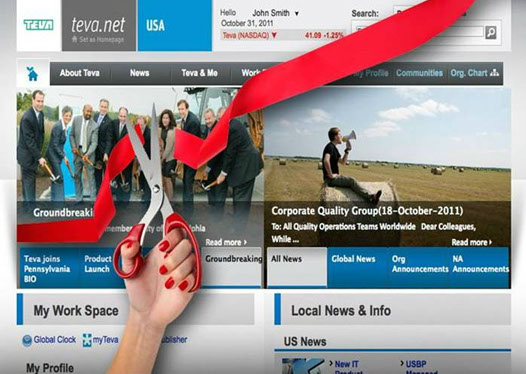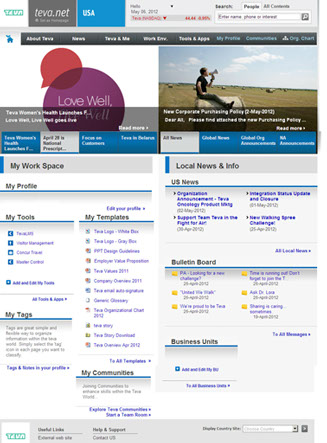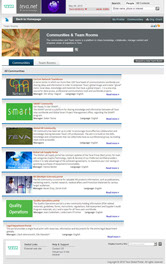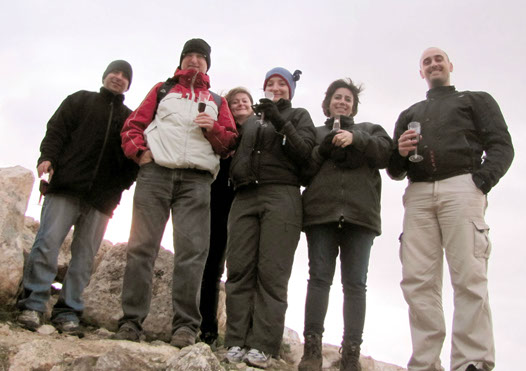


Teva.net global organizational Intranet goes live in Israel and the U.S.
Two years ago, Teva’s internal web domain looked very different. There were multiple interfaces, platforms, designs and even differing levels of security. Each Teva location had its own local intranet and, in most cases, these didn’t talk to any other Teva sites. And the diversity was increasing with every new Teva integration.

What was needed was a single entry point; a one stop shop to timely and relevant knowledge about the organization and areas of expertise that would also serve as a gateway to operative services, resources and activities. Moreover, this new portal would have to provide a seamless and engaging user experience.
The end result of these requirements ultimately became “teva.net,” the company’s new global organizational intranet. The project was set in motion by Eyal Desheh, Teva’s CFO, who crafted the vision and supported the project from the outset. Yossi Koren, VP of Corporate Communications joined the project in 2011 as a business owner and developed the new visual language that has been implemented in print and online channels across Teva worldwide.
The goals for teva.net were to have better accessibility to content and services; to enhance the internal service level; to be one of the main cultural tools in the company; and to achieve cost savings by enabling Teva staff to create content and structure once, then publish it in many ways to many users.
The intranet planning process began in April 2010 at a global kickoff meeting in Israel with 30 representatives from Teva business units around the world. The meeting focused on cross-business and cross-regional collaboration. “We wanted there to be a thorough understanding, discussion and agreement on various aspects of the process and content,” explains Orly Pascal from Corporate Internal Communications, the business owner for teva.net. “That would ensure that the intranet would meet the needs of the organization and support the strategy.”
Leah Gellman, also from Corporate Internal Communications, adds that, “Our main aim is that teva.net will be the home page of every employee and will enable us to convey a consistent message of 'One Teva.'”
Israel was identified as the first launch goal for teva.net; the intranet was deployed there in March 2011. The Unites States followed, launching at the end of 2011. The European “go-live” for teva.net is starting now, in Q1 2012. The rollout and planning are also now underway for Canada and Latin America.
The planning, development and launch of teva.net has been performed by Teva’s Portals and Web Solution (PWS) unit, a new group in the Corporate IT Shared Services Center (SSC) led by Amizur Rokach. PWS was established to answer several business and IT needs within the web area in Teva: Web Solutions (where no “off-the-shelf” applications are available); Global Intranet; Extranet Portals; and Commercial Websites (such as tevapharm.com). The development Delivery Center supporting these four business areas is located in Croatia.
Liat Verov, teva.net project manager, explains that teva.net has been built to be structured yet flexible. The layout and design of the site is the same for all locations worldwide, while the content and language are a mix of local and global elements for each country. Teva.net meets three key business requirements:
1. Provide updated organizational information, including:
• News and information about company activities, best practices, global projects, new products and campaigns.
• HR data, including personal salary and benefit details along with the ability to update vacation days and travel expense reports, all in one place.
• An “Application Launcher” that links to specific applications – such as the Business Intelligence dashboard – directly from teva.net. Operational services – such as notifications from back end systems, or ordering over-the-counter medicine direct from Teva or tickets for a movie showing at one of the company’s offices – are also supported.
2. Enable users to connect globally through network features, including:
• A global address book
• Personal profiles that employees can “opt in” to include their photos, birthdays, professional experience and other useful information.
• An interactive organizational chart.
• Messages and notifications, as well as the ability to post status updates.
• Full integration with Outlook and Outlook Communicator (OCS), enabling users to access their email, calendar and instant messaging directly from the Intranet.
• Blogs and Wikis – users can create their own, within guidelines. Some teams are already using Wikis to share documentation.
3. Facilitate Collaboration
A major change to the way resources are shared is the creation of “team rooms and communities” for collaboration that provide a platform for professional and social dialogue and shared content between employees.
Currently, many employees have access to shared documents via shared folders. As individuals and teams collaborate more globally, those locally shared folders don’t always work. Employees must request access and wait for IT to grant it. With team spaces, collaboration can begin without delay, worldwide.
One example of a global community is the Quality group, with 400 community members who can share professional literature, policies and procedures, marketing materials and a calendar of events.
Denise Bradley, VP of Corporate Communications for Teva Americas, is particularly excited about the ability to unify communication around the world, especially as Teva continues to grow. “We’re adding new people all the time – in Israel, Asia, the US and Latin America – and it’s important to be able to share the same resources. It also makes it easier when employees travel or even transfer between divisions.”
External partners and suppliers can also access teva.net; the permissions functionality ensures that they can only get into the sections that are appropriate for their jobs. For instance, in Teva’s joint venture with Proctor and Gamble, Teva can’t see P&G’s internal site, just as they can’t see into Teva. Both parties can, however, share information in the joint venture’s team room on teva.net.
The teva.net system is based on Microsoft SharePoint 2010, an entirely new technology at Teva that requires all users to upgrade to Internet Explorer version 7 and above. That in itself was a challenge, since most of Teva was using IE 6 until recently.
Measuring success can be seen in several ways. One is simply by the number of users on the system: about 10,000 employees are currently using teva.net. This will increase as more countries join the platform, and as more of the “old” portals are decommissioned. The local Israeli and U.S. intranets are due to be phased out in Q1 2012.
Another indication of accomplishment is the initial feedback received. Says Lauren Chrisman, from Corporate Communications of Teva Americas, “We’re hearing from people that it’s a lot cleaner and more modern looking than the old intranet. When they then ask ‘how can I be the content owner for a specific section,’ you know people are ready to jump on board.”
Rolling out teva.net has involved some significant change management activity, training and support. There were separate training sessions for content owners and site owners. A support system was built so that users with questions or problems can submit tickets. Though most of the training for country site owners took place in person, the majority of the collaboration training and support is being handled virtually.
Most of all, teva.net is not really a start-to-finish “project.” One could say that the project is a continual work in progress in terms of the need for constant iteration and improvement based on user requirements.
